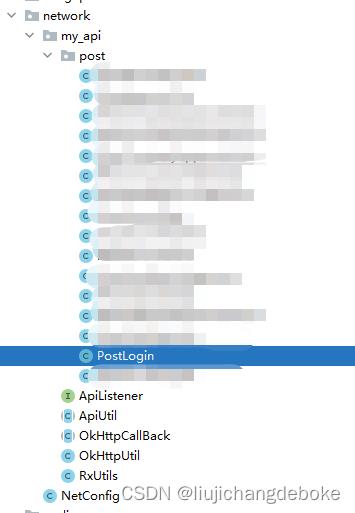Android项目中okhttp3的简易封装和使用
Posted liujichangdeboke
tags:
篇首语:本文由小常识网(cha138.com)小编为大家整理,主要介绍了Android项目中okhttp3的简易封装和使用相关的知识,希望对你有一定的参考价值。
1、所有文件:

2、OkHttpUtil类
这个类主要用于初始化okhttp和发送http请求。
public class OkHttpUtil
private static OkHttpClient mOkHttpClient = null;
//Call this method in the Application class. ---> onCreate() method.
//Thus we can get only one instance of httpClient in the whole app.
public static void init()
if (mOkHttpClient == null)
OkHttpClient.Builder builder = new OkHttpClient().newBuilder()
.connectTimeout(5000, TimeUnit.MILLISECONDS)
.readTimeout(5000, TimeUnit.MILLISECONDS)
.writeTimeout(5000, TimeUnit.MILLISECONDS)
.sslSocketFactory(RxUtils.createSSLSocketFactory(),new RxUtils.TrustAllManager())
.hostnameVerifier(new RxUtils.TrustAllHostnameVerifier());
mOkHttpClient = builder.build();
//If GET method needs some other params, just need to add a HaspMap. Refer to:https://www.imooc.com/video/18685
public static void get(String url, OkHttpCallBack okHttpCallback)
Call call = null;
try
Request request = new Request.Builder().url(url).build();
call = mOkHttpClient.newCall(request);
call.enqueue(okHttpCallback);
catch(Exception ex)
ex.printStackTrace();
public static void post(String url, OkHttpCallBack okHttpCallback, HashMap<String, String> bodyMap)
Call call = null;
try
FormBody.Builder builder = new FormBody.Builder();
for (HashMap.Entry<String, String> entry : bodyMap.entrySet())
builder.add(entry.getKey(), entry.getValue());
RequestBody body = builder.build();
Request.Builder builderRequest = new Request.Builder();
// builderRequest.headers(new Headers())
Request request = builderRequest.post(body).url(url).build();
call = mOkHttpClient.newCall(request);
call.enqueue(okHttpCallback);
catch(Exception ex)
ex.printStackTrace();
public static void postHasFile(String url, OkHttpCallBack okHttpCallback, HashMap<String, String> bodyMap, String filesKey, List<File> files)
Call call = null;
try
MultipartBody.Builder multipartBodyBuilder = new MultipartBody.Builder();
multipartBodyBuilder.setType(MultipartBody.FORM);
for (HashMap.Entry<String, String> entry : bodyMap.entrySet())
multipartBodyBuilder.addFormDataPart(entry.getKey(), entry.getValue());
//遍历paths中所有图片绝对路径到builder,并约定key如“upload”作为后台接受多张图片的key
if (files != null)
for (File file : files)
multipartBodyBuilder.addFormDataPart(filesKey, file.getName(), RequestBody.create(MediaType.parse("image/png"), file));
RequestBody body = multipartBodyBuilder.build();
Request.Builder builderRequest = new Request.Builder();
// builderRequest.headers(new Headers())
Request request = builderRequest.post(body).url(url).build();
call = mOkHttpClient.newCall(request);
call.enqueue(okHttpCallback);
catch(Exception ex)
ex.printStackTrace();
1、在application中调用init方法初始化okhttp。
2、使用post方法:
(1)第一个(post)是不上传图片的请求,只需传入请求url、map形式的上传参数,一个请求监听。
(2)第二个(postHasFile)为上传文件请求,本人项目中只需上传一个图片列表,所以只增加了
String filesKey, List<File> files
两个参数。如果有其他需求,可以修改此处代码:
MultipartBody.Builder multipartBodyBuilder = new MultipartBody.Builder();
multipartBodyBuilder.setType(MultipartBody.FORM);
for (HashMap.Entry<String, String> entry : bodyMap.entrySet())
multipartBodyBuilder.addFormDataPart(entry.getKey(), entry.getValue());
//遍历paths中所有图片绝对路径到builder,并约定key如“upload”作为后台接受多张图片的key
if (files != null)
for (File file : files)
multipartBodyBuilder.addFormDataPart(filesKey, file.getName(), RequestBody.create(MediaType.parse("image/png"), file));
2、OkHttpCallBack
这个类简单封装了Okhttp的callback方法并以jsonObject回调给请求。
import android.util.Log;
import com.google.gson.Gson;
import org.json.JSONException;
import org.json.JSONObject;
import org.json.JSONTokener;
import java.io.IOException;
import okhttp3.Call;
import okhttp3.Callback;
import okhttp3.Response;
//The class to deal with the OkHttpCallback
public abstract class OkHttpCallBack implements Callback
public abstract void onSuccess(final Call call, JSONObject jsonObject);
@Override
public void onResponse(Call call, Response response) throws IOException
Log.d("OkHttpCallBackResponse:",call.toString()+"\\r\\n//reponse"+response.toString()+"\\r\\nresponse.headers:"+response.headers()
+"\\r\\nreponse.message:"+response.message());
if (response != null)
String str = response.body().string().trim();
Log.d("OkHttpCallBackResponse","//body::"+str);
if (response.isSuccessful())
try
JSONObject object = (JSONObject)new JSONTokener(str).nextValue();
if (object != null)
onSuccess(call, object);
else
onFailure(call, null);
catch(JSONException e)
e.printStackTrace();
onFailure(call, null);
else
onFailure(call, null);
@Override
public void onFailure(Call call, IOException e)
Log.d("OkHttpCallBackFail",call.toString()+"//"+e.toString());
3、RxUtils
这个类是为了配置请求证书 (https需要)。
import java.security.SecureRandom;
import java.security.cert.CertificateException;
import java.security.cert.X509Certificate;
import javax.net.ssl.HostnameVerifier;
import javax.net.ssl.SSLContext;
import javax.net.ssl.SSLSession;
import javax.net.ssl.SSLSocketFactory;
import javax.net.ssl.TrustManager;
import javax.net.ssl.X509TrustManager;
//在okhttp中设置信任所有证书
public class RxUtils
@SuppressLint("TrulyRandom")
public static SSLSocketFactory createSSLSocketFactory()
SSLSocketFactory sSLSocketFactory = null;
try
SSLContext sc = SSLContext.getInstance("TLS");
sc.init(null, new TrustManager[]new TrustAllManager(),
new SecureRandom());
sSLSocketFactory = sc.getSocketFactory();
catch (Exception ignored)
return sSLSocketFactory;
public static class TrustAllManager implements X509TrustManager
@SuppressLint("TrustAllX509TrustManager")
@Override
public void checkClientTrusted(X509Certificate[] chain, String authType)
throws CertificateException
@SuppressLint("TrustAllX509TrustManager")
@Override
public void checkServerTrusted(X509Certificate[] chain, String authType)
throws CertificateException
@Override
public X509Certificate[] getAcceptedIssuers()
return new X509Certificate[0];
public static class TrustAllHostnameVerifier implements HostnameVerifier
@SuppressLint("BadHostnameVerifier")
@Override
public boolean verify(String hostname, SSLSession session)
return true;
4、 NetConfig
此类主要写了baseurl和各个请求接口url。
public class NetConfig
public static String BASE_URL = "http://111.111.1.111:8081/";
//登录
public static String LOGIN = BASE_URL+"mobileApi/user/login";
5、ApiUtil
这个类为每个请求的基类
import android.os.Handler;
import android.os.Message;
import android.util.Log;
import androidx.annotation.NonNull;
import org.json.JSONObject;
import java.io.File;
import java.io.IOException;
import java.util.HashMap;
import java.util.List;
import okhttp3.Call;
public abstract class ApiUtil
private ApiListener mApiListener = null;
private static final int SUCCESS = 1;
private static final int FAIRURE = 2;
private Handler handler = new Handler()
@Override
public void handleMessage(@NonNull Message msg)
super.handleMessage(msg);
switch (msg.what)
case SUCCESS:
mApiListener.success(ApiUtil.this);
break;
case FAIRURE:
mApiListener.failrure(ApiUtil.this);
break;
;
public boolean mStatus = false;
public String msg = "请求失败";
public String TAG = this.getClass().toString();
private OkHttpCallBack mSendListener = new OkHttpCallBack()
@Override
public void onSuccess(Call call, JSONObject jsonObject)
ApiUtil.this.mStatus = jsonObject.optBoolean("status");
ApiUtil.this.msg = jsonObject.optString("msg");
if (mStatus)
try
parseData(jsonObject);
handler.sendEmptyMessage(SUCCESS);
catch(IOException e)
handler.sendEmptyMessage(FAIRURE);
e.printStackTrace();
catch (Exception e)
handler.sendEmptyMessage(FAIRURE);
e.printStackTrace();
else
handler.sendEmptyMessage(FAIRURE);
@Override
public void onFailure(Call call, IOException e)
ApiUtil.this.msg = "链接失败";
ApiUtil.this.mStatus = false;
handler.sendEmptyMessage(FAIRURE);
;
// public boolean isSuccess()
// return "0".equals(mStatus) || "200".equals(mStatus);
//
protected abstract void parseData(JSONObject jsonObject) throws Exception;
protected abstract String getUrl();
//Send GET request
//Listener: Tell the app whether the GET reqeust is success.
public void get(ApiListener listener)
mApiListener = listener;
OkHttpUtil.get(getUrl(), mSendListener);
private HashMap<String, String> mBodyMap = new HashMap<>();
public void addParams(String key, String value)
mBodyMap.put(key, value);
public void clearParams()
mBodyMap.clear();
//Send POST request
//Listener: Tell the app whether the POST reqeust is success.
public void post(ApiListener listener)
mApiListener = listener;
OkHttpUtil.post(getUrl(), mSendListener, mBodyMap);
public void postFiles(ApiListener listener, String fileKey, List<File> fileList)
mApiListener = listener;
OkHttpUtil.postHasFile(getUrl(),mSendListener,mBodyMap,fileKey,fileList);
@Override
public String toString()
return "ApiUtil" +
"mApiListener=" + mApiListener +
", mStatus=" + mStatus +
", msg='" + msg + '\\'' +
", TAG='" + TAG + '\\'' +
", mSendListener=" + mSendListener +
",\\r\\n mBodyMap=" + mBodyMap +
'';
1、设置参数请求
public void addParams(String key, String value)
mBodyMap.put(key, value);
2、发送请求
public void post(ApiListener listener)
mApiListener = listener;
OkHttpUtil.post(getUrl(), mSendListener, mBodyMap);
public void postFiles(ApiListener listener, String fileKey, List<File> fileList)
mApiListener = listener;
OkHttpUtil.postHasFile(getUrl(),mSendListener,mBodyMap,fileKey,fileList);
以登陆接口为例

public class PostLogin extends ApiUtil
public UserBeans mResponse;
public PostLogin(String userName, String passWord)
addParams("userCode", userName);
addParams("userPassword", passWord);
@Override
protected void parseData(JSONObject jsonObject) throws Exception
mResponse = new Gson().fromJson(jsonObject.optString("data"),UserBeans.class);
@Override
protected String getUrl()
return NetConfig.LOGIN;
1、可以在初始化时添加参数,或者生成postLogin实例后传参。
2、在getUrl()方法中回调给父类请求URL。
3、可以在parseData(JSONObject jsonObject)中解析返回的数据,然后定义实体类作为接收:
public UserBeans mResponse;
@Override
protected void parseData(JSONObject jsonObject) throws Exception
mResponse = new Gson().fromJson(jsonObject.optString("data"),UserBeans.class);
在LoginActivity中调用
private void login()
if (TextUtils.isEmpty(edtUserName.getText().toString()))
toShortToast("请输入用户名");
return;
if (TextUtils.isEmpty(edtPassword.getText().toString()))
toShortToast("请输入密码");
return;
showLoadingDialog("登录中...");
new PostLogin(edtUserName.getText().toString(), edtPassword.getText().toString()).post(new ApiListener()
@Override
public void success(ApiUtil apiUtil)
toShortToast(apiUtil.msg);
PostLogin postLogin = (PostLogin) apiUtil;
SPUtil.put(context, SpKeys.KEY_LOGIN_USER_NAME, edtUserName.getText().toString());
SPUtil.put(context, SpKeys.KEY_USER_ID, postLogin.mResponse.getUserId());
SPUtil.put(context, SpKeys.KEY_USER_TYPE, postLogin.mResponse.getUserType());
if (isRememberPw)
SPUtil.put(context, SpKeys.KEY_LOGIN_PASSWORD, edtPassword.getText().toString());
else
SPUtil.put(context, SpKeys.KEY_LOGIN_PASSWORD, "");
Intent intent = new Intent();
intent.setClass(context, MainActivity.class);
context.startActivity(intent);
stopLoadingDialog();
finish();
@Override
public void failrure(ApiUtil apiUtil)
stopLoadingDialog();
toShortToast(apiUtil.msg);
);
请求监听接口中 success(ApiUtil apiUtil)方法回调 接收的数据
PostLogin postLogin = (PostLogin) apiUtil;
postLogin.mResponse为已经解析好的实体类。
后补:ApiListener
public interface ApiListener
//Request success
void success(ApiUtil apiUtil);
//Request failed
void failrure(ApiUtil apiUtil);
以上是关于Android项目中okhttp3的简易封装和使用的主要内容,如果未能解决你的问题,请参考以下文章